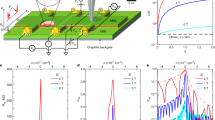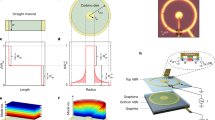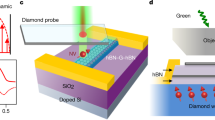Abstract
A variety of physical phenomena associated with nanoscale electron transport often results in non-trivial spatial voltage and current patterns, particularly in nonlocal transport regimes. While numerous techniques have been devised to image electron flows, the need remains for a nanoscale probe capable of simultaneously imaging current and voltage distributions with high sensitivity and minimal invasiveness, in a magnetic field, across a broad range of temperatures and beneath an insulating surface. Here we present a technique for spatially mapping electron flows based on a nanotube single-electron transistor, which achieves high sensitivity for both voltage and current imaging. In a series of experiments using high-mobility graphene devices, we demonstrate the ability of our technique to visualize local aspects of intrinsically nonlocal transport, as in ballistic flows, which are not easily resolvable via existing methods. This technique should aid in understanding the physics of two-dimensional electronic devices and enable new classes of experiments that image electron flow through buried nanostructures in the quantum and interaction-dominated regimes.
This is a preview of subscription content, access via your institution
Access options
Access Nature and 54 other Nature Portfolio journals
Get Nature+, our best-value online-access subscription
$29.99 / 30 days
cancel any time
Subscribe to this journal
Receive 12 print issues and online access
$259.00 per year
only $21.58 per issue
Buy this article
- Purchase on Springer Link
- Instant access to full article PDF
Prices may be subject to local taxes which are calculated during checkout





Similar content being viewed by others
Data availability
The data that support the plots and other analysis in this work are available from the corresponding author upon request.
References
Beenakker, C. W. J. & van Houten, H. Quantum transport in semiconductor nanostructures. Solid State Phys. Adv. Res. Appl. 44, 1–228 (1991).
Hasan, M. Z. & Kane, C. L. Colloquium: topological insulators. Rev. Mod. Phys. 82, 3045–3067 (2010).
Qi, X.-L. & Zhang, S.-C. Topological insulators and superconductors. Rev. Mod. Phys. 83, 1057–1110 (2011).
Lucas, A. & Fong, K. C. Hydrodynamics of electrons in graphene. J. Phys. Condens. Matter 30, 053001 (2018).
Landauer, R. Conductance determined by transmission: probes and quantised constriction resistance. J. Phys. Condens. Matter 1, 8099–8110 (1989).
McLennan, M. J., Lee, Y. & Datta, S. Voltage drop in mesoscopic systems: a numerical study using a quantum kinetic equation. Phys. Rev. B 43, 13846–13884 (1991).
Datta, S. Electron Transp ort Mesoscopic System (Cambridge Univ. Press, 1997).
Muralt, P. & Pohl, D. W. Scanning tunneling potentiometry. Appl. Phys. Lett. 48, 514–516 (1986).
McCormick, K. L. et al. Scanned potential microscopy of edge and bulk currents in the quantum Hall regime. Phys. Rev. B 59, 4654–4657 (1999).
Bachtold, A. et al. Scanned probe microscopy of electronic transport in carbon nanotubes. Phys. Rev. Lett. 84, 6082–6085 (2000).
Weitz, P., Ahlswede, E., Weis, J., Klitzing, K. V. & Eberl, K. Hall-potential investigations under quantum Hall conditions using scanning force microscopy. Phys. E 6, 247–250 (2000).
Melitz, W., Shen, J., Kummel, A. C. & Lee, S. Kelvin probe force microscopy and its application. Surf. Sci. Rep. 66, 1–27 (2011).
Roth, B. J., Sepulveda, N. G. & Wikswo, J. P. Using a magnetometer to image a two-dimensional current distribution. J. Appl. Phys. 65, 361–372 (1989).
Tokura, Y., Honda, T., Tsubaki, K. & Tarucha, S. Noninvasive determination of the ballistic-electron current distribution. Phys. Rev. B 54, 1947–1952 (1996).
Huber, M. E. et al. Gradiometric micro-SQUID susceptometer for scanning measurements of mesoscopic samples. Rev. Sci. Instrum. 79, 053704 (2008).
Rondin, L. et al. Magnetometry with nitrogen-vacancy defects in diamond. Rep. Prog. Phys. 77, 056503 (2014).
Tetienne, J.-P. et al. Quantum imaging of current flow in graphene. Sci. Adv. 3, e1602429 (2017).
Chang, K., Eichler, A., Rhensius, J., Lorenzelli, L. & Degen, C. L. Nanoscale imaging of current density with a single-spin magnetometer. Nano Lett. 17, 2367–2373 (2017).
Vasyukov, D. et al. A scanning superconducting quantum interference device with single electron spin sensitivity. Nat. Nanotechnol. 8, 639–644 (2013).
Eriksson, M. A. et al. Cryogenic scanning probe characterization of semiconductor nanostructures. Appl. Phys. Lett. 69, 671–673 (1996).
Bhandari, S. et al. Imaging cyclotron orbits of electrons in graphene. Nano Lett. 16, 1690–1694 (2016).
Fei, Z. et al. Gate-tuning of graphene plasmons revealed by infrared nano-imaging. Nature 487, 82–85 (2012).
Chen, J. et al. Optical nano-imaging of gate-tunable graphene plasmons. Nature 487, 77–81 (2012).
Mueller, T., Xia, F., Freitag, M., Tsang, J. & Avouris, P. Role of contacts in graphene transistors: a scanning photocurrent study. Phys. Rev. B 79, 245430 (2009).
Fontein, P. F. et al. Spatial potential distribution in GaAs/AlxGa1-xAs heterostructures under quantum Hall conditions studied with the linear electro-optic effect. Phys. Rev. B 43, 12090–12093 (1991).
Knott, R., Dietsche, W., v. Klitzing, K., Eberl, K. & Ploog, K. Inside a 2D electron system: images of potential and dissipation. Solid. State. Electron. 37, 689–692 (1994).
Gao, C., Wei, T., Duewer, F., Lu, Y. & Xiang, X. D. High spatial resolution quantitative microwave impedance microscopy by a scanning tip microwave near-field microscope. Appl. Phys. Lett. 71, 1872–1874 (1997).
Wang, Z. et al. Quantitative measurement of sheet resistance by evanescent microwave probe. Appl. Phys. Lett. 86, 153118 (2005).
Yoo, M. J. et al. Scanning single-electron transistor microscopy: imaging individual charges. Science 276, 579–582 (1997).
Ilani, S. et al. The microscopic nature of localization in the quantum Hall effect. Nature 427, 328–332 (2004).
Honig, M. et al. Local electrostatic imaging of striped domain order in LaAlO3/SrTiO3. Nat. Mater. 12, 1112–1118 (2013).
Yacoby, A., Hess, H. F., Fulton, T. A., Pfeiffer, L. N. & West, K. W. Electrical imaging of the quantum Hall state. Solid State Commun. 111, 1–13 (1999).
Waissman, J. et al. Realization of pristine and locally tunable one-dimensional electron systems in carbon nanotubes. Nat. Nanotechnol. 8, 569–574 (2013).
Ben Shalom, M. et al. Quantum oscillations of the critical current and high-field superconducting proximity in ballistic graphene. Nat. Phys. 12, 318–322 (2016).
Levinson, I. B. Potential distribution in a quantum point contact. Sov. Phys. JETP 68, 1257–1265 (1989).
Xia, F., Perebeinos, V., Lin, Y. M., Wu, Y. & Avouris, P. The origins and limits of metal-graphene junction resistance. Nat. Nanotechnol. 6, 179–184 (2011).
Yu, Y. J. et al. Tuning the graphene work function by electric field effect. Nano Lett. 9, 3430–3434 (2009).
Morikawa, S. et al. Imaging ballistic carrier trajectories in graphene using scanning gate microscopy. Appl. Phys. Lett. 107, 243102 (2015).
Bhandari, S. et al. Imaging electron flow from collimating contacts in graphene. 2D Mater. 5, 021003 (2018).
Tarucha, S., Saku, T., Tokura, Y. & Hirayama, Y. Sharvin resistance and its breakdown observed in long ballistic channels. Phys. Rev. B 47, 4064–4067 (1993).
Falkovich, G. & Levitov, L. Linking spatial distributions of potential and current in viscous electronics. Phys. Rev. Lett. 119, 066601 (2017).
Acknowledgements
We thank G. Falkovich, L. Levitov, A. Shytov and A. Stern for discussions and D. Mahalu for electron-beam lithography. We further acknowledge support from the Helmsley Charitable Trust grant, the ISF (grant no. 712539), WIS-UK collaboration grant and the ERC-Cog (See-1D-Qmatter, no. 647413).
Author information
Authors and Affiliations
Contributions
L.E., S.I. and J.A.S. conceived the technique. L.E., A.R., S.I. and J.A.S. created the SETs, performed the measurements and analysed the data. J.B., D.P., J.Z. and M.B.-S. fabricated the graphene devices. K.W. and T.T. supplied the hBN crystals. L.E., S.I. and J.A.S. wrote the manuscript with input from all authors.
Corresponding author
Ethics declarations
Competing interests
The authors declare no competing interests.
Additional information
Journal peer review informationNature Nanotechnology thanks Klaus Ensslin and other anonymous reviewer(s) for their contribution to the peer review of this work.
Publisher’s note: Springer Nature remains neutral with regard to jurisdictional claims in published maps and institutional affiliations.
Supplementary information
Supplementary Information for
“Simultaneous voltage and current density imaging of flowing electrons in two
Rights and permissions
About this article
Cite this article
Ella, L., Rozen, A., Birkbeck, J. et al. Simultaneous voltage and current density imaging of flowing electrons in two dimensions. Nat. Nanotechnol. 14, 480–487 (2019). https://doi.org/10.1038/s41565-019-0398-x
Received:
Accepted:
Published:
Issue Date:
DOI: https://doi.org/10.1038/s41565-019-0398-x
This article is cited by
-
Characterization of Two Fast-Turnaround Dry Dilution Refrigerators for Scanning Probe Microscopy
Journal of Low Temperature Physics (2024)
-
Imaging hydrodynamic electrons flowing without Landauer–Sharvin resistance
Nature (2022)
-
Hydrodynamic approach to two-dimensional electron systems
La Rivista del Nuovo Cimento (2022)
-
Propagation of shear stress in strongly interacting metallic Fermi liquids enhances transmission of terahertz radiation
Scientific Reports (2021)
-
Atomic-like charge qubit in a carbon nanotube enabling electric and magnetic field nano-sensing
Nature Communications (2020)



